As oilseed rape hangs in the balance on many farms, one Suffolk arable business has a system, backed up with dependable genetics, that puts prospects firmly in its favour. CPM visits to glean some experience.
The main aspect is that I have the confidence to continue with oilseed rape.
By Tom Allen-Stevens
Dan Kiddy takes hold of a stem of his DK Exstar oilseed rape and pulls it, intending to reveal how the taproot has shaped up beneath the thick stem. But despite the recent rainfall – and current heavy downpour – having softened up the clay loam soil, it’s reluctant to release the plant.
Eventually it comes free, with a crack denoting most of the root has been left behind, and Dan straightens up to inspect the stem in his hand. “Get a stem like that and cabbage stem flea beetle larvae don’t bother the crop,” he says.
As manager of Wm Kerr Farms, near Woodbridge, Suffolk, Dan looks after the agronomy of all the cropping, which includes winter wheat, hybrid winter barley, potatoes, sugar beet, maize and asparagus. Although many OSR crops locally have been hit with CSFB, he’s maintained the performance of the 40ha through applying two rules he sees as fundamental: “You lock in moisture and grow it well.
“There’s always a patch of damp weather in August. We find we get best results if we go through with our one-pass system with low disturbance points timed to make the most of that moisture. Then – crucially – double-roll afterwards. The CSFB doesn’t like that.”
A Simba Flatliner five-leg subsoiler has been modified with an Opico Hatzenbichler seeder unit dropping the seed behind the low-disturbance legs into 60cm rows. “Previously we used a Väderstad TopDown, but it moved too much soil which dried it out. We started on this system ten years ago and haven’t looked back.”
There’s another key ingredient to the system Dan’s key to emphasise: variety choice. “We’ve grown Dekalb hybrids ever since DK Cabernet and nowadays won’t look at a variety that doesn’t have DK in front of it. It’s the ease of management you get, plus their get-up-and-go – that’s a given. Current varieties also score well on stem canker, light leaf spot and lodging.”
Dan’s always on the look-out for what new properties are coming through the DK lines, though. So this year his crop is split between DK Exalte and DK Exstar with a 5ha field of DK Expectation. A keen advocate of on-farm trials, he’s also planted 1ha each of newcomers DK Excited and DK Extremus into a field of Exstar.
He’s joined by local Bayer commercial technical manager Ella Crawford who’s been helping to monitor the field-scale trial through the season. Top of mind is how the three varieties performed at establishment. “All of them have the in-built autumn vigour that helps them get away and you couldn’t really tell the difference. Combined with Dan’s establishment system, that meant he could stick to the farm’s resolve not to apply any insecticides,” she notes.
Ella points out that a fast, successful establishment allows the crop to withstand CSFB damage and is far more effective than spraying pyrethroids. “Coupled with that, resistance is rising. If you spray and subsequent monitoring shows a poor result, don’t spray again.”
Having drilled in the second week of Aug, Dan applied 160kg/ha of DAP to the seedbed, delivering 30kgN/ha. “We had quite a few barley volunteers that we took out early on with propaquizafop, but didn’t apply a pre-emergence herbicide. Belkar (halauxifen-methyl+ picloram) went on for broadleaf weeds, then Proline (prothioconazole) was applied with the propyzamide in early Nov to check disease.”
Ella took some leaves of Excited and Extremus in mid March as part of Bayer’s SpotCheck initiative to help growers identify LLS and phoma in the growing crop. “Both were very low for LLS at 3% and 7% respectively while the Excited had just 3% phoma. That’s down to good genetics as well as the Nov treatment.”
Dan applied a late March treatment of tebuconazole. “I would have applied Proline again if the risk had been higher,” he notes. A mid-flowering treatment of azoxystrobin plus boscalid has been applied for sclerotinia and to maintain a green canopy. “We suffered last year from small seeds, so keen to give the crop every chance to fill the pods,” he adds.
Nitrogen was applied with sulphur in mid-Feb and then as urea three weeks later to bring the total applied to 250kgN/ha. “I like to get the first N on by Valentine’s Day with the rest applied before it gets dry – we just about achieved that this year.”
So how have the varieties fared through the season? “Extremus was notably earlier to flower. Bearing in mind the consecutive frosts we had in April, that may not be a good thing for pod set, though. Exstar and Excited came later, otherwise there’s very little difference between them,” reports Dan.
“All varieties have stood well and I’ve not noticed any larval damage. I think a lot of that is down to the good, thick stems, which again comes from a combination of good genetics and our establishment system.”
Ella notes that Excited and Expectation both have resistance to TuYV, which should offer them an advantage, although no symptoms have been spotted in the crop. “Extremus has early regrowth in the spring which may offer an advantage. But the Exstar already has good genetics with its triple 8 for phoma, LLS and stem stiffness. All varieties of course have the security of pod-shatter resistance.”
It’s a trait Dan values after his crop suffered in a hailstorm a few years ago shortly before harvest. “I was trialling DK Exalte next to a non-DK variety that didn’t have pod-shatter resistance. The outcome was quite stark with the non-DK area white where the seeds had been knocked from the pods. As for yield, the Exalte achieved 3.5t/ha while the other variety produced less than 0.5t/ha. If pod shatter’s available, you’d be foolish not to take it,” he says.
It’s the Exalte that’s due to be switched out of the rotation after this year’s harvest, but Dan won’t decide which new variety will take its place until the combine goes in. “The Exstar with its triple 8 has already moved the genetics on. I’ve kept a close eye on the trial field and both Extremus and Excited have looked very promising all season. I’m keen to know whether those frosts have had any effect, so will look at pod set and scrutinise the yield results.
“The main aspect is that I have the confidence to continue with OSR. I’m convinced that comes down to getting the basics right along with having genetics you can rely on,” concludes Dan.
Yield’s not the core focus as traits progress
Look across the AHDB Recommended List and you’d be forgiven for thinking Dekalb varieties don’t feature much in the UK. But commercial seed sales paint a very different picture, with DK lines picking up a healthy 27% of the hybrid market.
So why is this? “We’ve always bred for robust varieties, homing in on traits that we know really matter to UK growers,” explains Bayer UK genetics campaign manager Lizzie Carr-Archer. “We’ve focused on successful establishment, stem stiffness, a good disease profile and traits such as resistance to pod-shatter and TuYV. Yield comes secondary, although such is the nature of OSR, if you get the key traits right, you’re rewarded with yield.”
A particular focus in recent years has been characterising autumn and spring development, she notes. “That’s gone along with improving stem stiffness, so we’re confident that all of our key varieties (see table below) are suitable for early drilling and have the vigour, both in autumn and spring, to pull away from CSFB pressure.”
By breeding for these key characteristics, rather than for RL inclusion, Lizzie believes the DK lines perform well and most importantly reliably on farm.
For those who prefer an RL variety, DK Expectation sits as a top performer for growers in the East and West regions and has TuYV resistance, while DK Exsteel is recommended for the North. “Our other four key varieties are supported by the Dekalb Establishment Scheme, which gives growers the confidence to invest in new genetics.”
Under the scheme, if growers have sown one of the specified four varieties before 20 Sept but it fails to establish by the end of Oct, they can claim a credit of £100/bag. “It’s that first 6-8 weeks that’s crucial and requires the attention to detail to build the tap root. Once that’s established, the crop’s in a much better position to fend for itself,” Lizzie notes.
Bayer’s European breeding centre at Boissay in the Paris basin is where the development work comes together for the lines that eventually make their way to the UK farmer. A €15 million investment programme has expanded the facility, allowing Dekalb French breeding programme leader, Julien Binet and colleagues to increase the number of crosses they make and cut the time it takes to bring in and transfer traits.
“We’ve introduced greater diversity at the heart of our OSR breeding engine with a major expansion of our di-haploid laboratory which creates genetically pure lines from single pollen grains,” he explains.
“At the same time, we use genome-wide selection – high-capacity genetic mapping allows us to identify whole blocks of genes associated with the superior performance of our most successful hybrids in different environments and track these within our parent lines. That means we can estimate with considerable accuracy the overall breeding value of hybrid parents for the outcomes we want.”
Testing the outcome is carried out across a trials network that remains completely untreated to put varieties under a fair degree of stress and tease out the ones that perform, notes Dekalb UK and Nordics breeding leader, Matthew Clarke.
“This carries right through to their NL2 stage of development. And we deliberately do so in situations known to present particular disease, pest and other environmental challenges.
“At the same time, this selection work allows us to identify the key genetic elements most associated with the resilience we identify in particular environments to feed back into our genome-wide selection programme,” he adds.
Matthew believes it’s this environmental resilience that results in the progressive improvement they’re building into Dekalb varieties, and that’s what brings the yield.
“As a hugely complex trait, yield is not something we can reliably breed for directly,” observes Julien. “And if we put too much general emphasis on breeding for yield, we can easily dilute important traits, which may prove catastrophic under the extremes of climate we’re seeing these days.
“We can also provide varieties purpose-built to perform under specific regimes, like early or later drilling, light or deep soils, or restrictive nitrogen regimes. Providing varieties growers know they can rely on is a difference they get from the Dekalb programme.”

Forward-thinking farmers
With robotics, gene mapping and molecular markers, digital technology and bio-chemistry it is a dynamic time for anyone involved in agriculture.
Challenges lie ahead for UK agriculture, such as improving productivity while minimising its environmental footprint. But farmers have always had to deal with change, and adopt new ideas and technology.
Bayer is at the core of these agricultural advances, working with farmers throughout the UK and further afield to trial and develop new diagnostic tools and evaluate different farming strategies, coupled with exciting plant breeding and product development programmes. It will help us develop innovative solutions and services to assist farmers achieve profitable and sustainable agronomic practices.
Despite the challenges facing UK agriculture there is much to look forward to. This series of articles focuses on how innovation and partnership between farmer and industry will help us face the future together.




